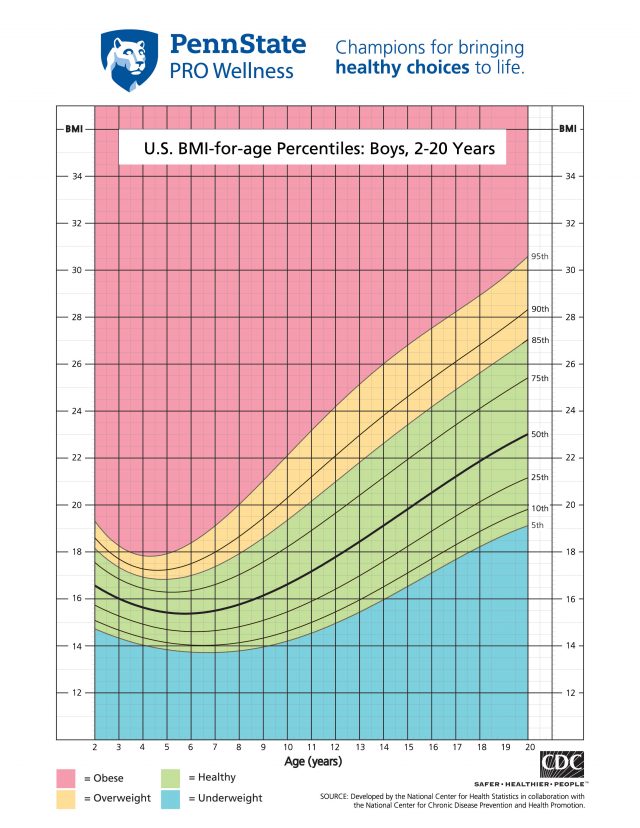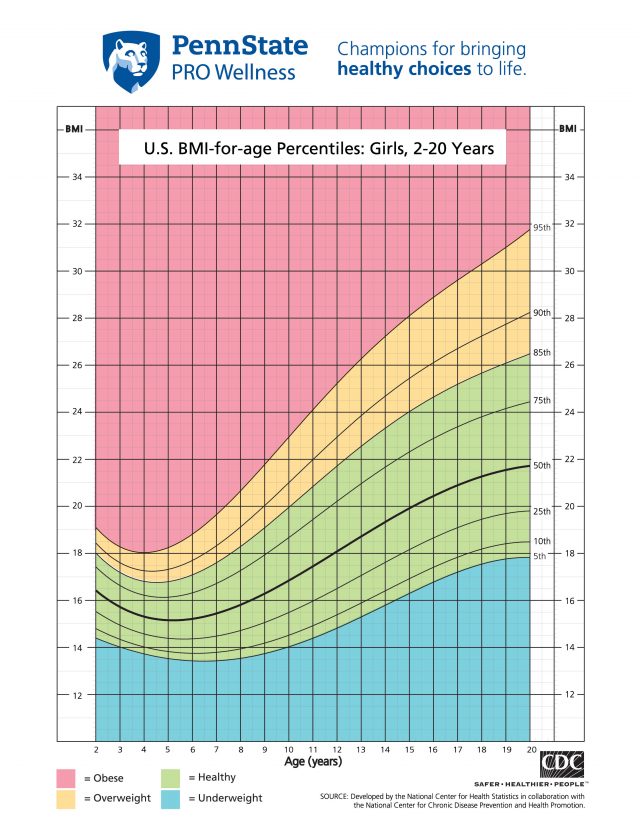Healthy You
-
Find Your Body Mass Index
The most common way to find out whether you’re overweight or obese is to determine your body mass index (BMI). BMI is an estimate of body fat, and it’s a good gauge of your risk for obesity related diseases. The higher your BMI, the higher your risk of developing health problems such as coronary heart disease, heart attack, blocked arteries, stroke, high blood pressure, Type 2 diabetes, and certain cancers.
There are many factors that determine your BMI, weight and body fat. They include genetics and family history, environmental factors and daily lifestyle choices. While factors like family history cannot be changed, there are many simple ways to bring healthy choices to life in order to reduce your risk for health problems and disease.
How do your healthy choices stack up? Use this calculator to calculate BMI for adults, 20 years old and older.
Adult BMI
- BMI below 18.5: underweight
- BMI of 18.5-24.9: healthy weight
- BMI of 25-29.9: overweight
- BMI of 30: obese
Please upgrade to web browser that supports iframes to see this CDC widget.Use this calculator to calculate BMI and the corresponding BMI-for-age percentile based on the CDC growth charts for children and teens (ages 2 through 19 years).
Child Percentile
- Less than 5th percentile: underweight
- 5th to less than 85th percentile: healthy weight
- 85th to less than 95th percentile: overweight
- Equal to or greater than 95th percentile: obese
BMI-for-age
BMI for children and young adults ages 2-20 is referred to as BMI-for-age. The reason for this is that body fat changes as you grow. BMI-for-age is plotted on separate growth charts to determine a BMI percentile ranking.
A BMI percentile is an indication of how a child’s measurements compare to others of the same age and gender. A child whose BMI is at the 50th percentile is close to the average of the population. A child above the 95th percentile is considered obese because 95 percent of the population weighs less than he or she does. A child below the 5th percentile is considered underweight because 95 percent of the population weighs more. You may receive these charts at your child’s yearly checkup.
-
Find Your Waist to Height Ratio (WHtR)
According to the National Heart Lung and Blood Institute, excess abdominal fat is an important, independent risk factor for disease. The evaluation of waist circumference to assess the risks associated with obesity or overweight is supported by research. In fact, studies have shown that WHtR is a stronger predictor of cardiovascular risk and mortality.
Your waist to height ratio is calculated by dividing waist size by height. If your waist measurement is less than half your height, you’re likely not at risk for obesity-related disease.
The following chart helps you determine if your WHtR falls in a healthy weight range:
Male
- Ratio less than 43%: underweight
- Ratio 43% to 52%: healthy weight
- Ratio 53% to 62%: overweight
- Ratio over 63%: obese
Female
- Ratio less than 42%: underweight
- Ratio 42% to 48%: healthy weight
- Ratio 49% to 57%: overweight
- Ratio over 58%: obese
Enter your information below:
-
How to be a Healthy Role Model
Whether you’re at risk of becoming obese, currently overweight or at a healthy weight, you can take steps to prevent unhealthy weight gain and related health problems. Not surprisingly, the steps to prevent weight gain are the same as the steps to lose weight: daily exercise, a healthy diet, and a long-term commitment to watch what you eat and drink.
Be a health champion for your child. The best way for you to encourage healthy eating is to eat well yourself. Children will follow the lead of the adults they see every day. By eating fruits and vegetables and not overindulging in less nutritious foods and beverages, you’ll be sending the right message.
Another way to be a good role model is to limit portions and not overeat. Talk about your feelings of fullness, especially with younger children. You might say, “This is delicious, but I’m full, so I’m going to stop eating.” Similarly, parents who are always dieting or complaining about their bodies may foster these same negative feelings in their children.
-
Limit Portion Sizes
In the last 20 years, our portion sizes have gotten much larger. In fact, larger portions make it easier to overeat or consume more energy than your body needs. A single meal can contain a whole day’s worth of calories.
A portion is defined as “the amount of food or drink you choose to eat.” A portion can include several food groups, like a sandwich (grain, meat, vegetable). Sometimes it’s okay to have more than one portion, like when you have been really active.
Just remember to pay attention to when you are truly hungry, eat slowly, and to stop eating when you are full.
See how some of the portions sizes have grown, for example:
- Today we have bagels that measure 6 inches wide. But a single serving is only 2 inches wide. The difference is 210 calories.
- The size of today’s typical cheeseburger has 590 calories, but 20 years ago a burger was the size of a kid’s meal burger. That’s a difference of 230 calories.
- The size of a soda 20 years ago was 6.5 ounces. Now we have 12-ounce cans and 20-ounce bottles! Imagine how the calorie count have doubled and tripled.
To learn the right amount of food for you and your child(ren), visit the USDA’s ChooseMyPlate guide.
Click on the resources listed below to download:
-
Change Your Food Attitude
Try to keep a positive attitude about food. It’s easy for food to become a source of conflict. Well-intentioned parents might find themselves bargaining or bribing children so they eat the healthy food in front of them. A better strategy is to give children some control, but to also limit the kind of foods available at home.
Children should decide if they’re hungry, what they will eat from the foods served, and when they’re full. Parents control which foods are available to the child, both at mealtime and between meals. Here are some guidelines to follow:
- Establish a predictable schedule of meals and snacks. It’s OK to choose not to eat when both parents and children know when to expect the next meal or snack.
- Don’t force children to clean their plates. Doing so teaches them to override feelings of fullness.
- Don’t bribe or reward children with food. Avoid using dessert as the prize for eating the meal.
- Don’t use food as a way of showing love. When you want to show love, give children a hug, some of your time, or praise.
-
Your Healthcare Provider
A child’s healthcare provider is the best health resource. Your provider can help assess your child’s risk for overweight or obesity. They can help to explain how a child is growing and, if need be, make recommended changes in eating or activity habits that can benefit the whole family. A registered dietitian is also uniquely qualified to help families recognize and change eating habits that could be contributing to excess weight gain in a child.
When speaking with your child’s health care provider, consider the following:
- Ask about your child’s blood pressure and whether it’s normal.
- Ask about additional tests (cholesterol, triglycerides, fasting glucose) to identify health risks that may be associated with your child’s weight.
- Create a plan for how your child’s growth and weight will be monitored and checked in the coming year.
- Ask your health care provider to refer additional support services, such as working with a dietitian for nutrition counseling, consulting a physical therapist if there are physical activity limitations, or other weight management services available in your area.
BMI and You Video
View VideoWhat overweight or obese means to you.
View VideoEnergy Balance Infographic Poster
DownloadEnergy Balance Quick Tips (English)
DownloadRethink Your Drink Infographic Poster
DownloadRethink Your Drink version 2.0 Infographic Poster
DownloadRethink Your Drink Quick Tips (English)
DownloadPortion Distortion Infographic Poster
DownloadPortion Distortion Quick Tips (English)
DownloadEnergy Balance Quick Tips (Spanish)
DownloadRethink Your Drink Quick Tips (Spanish)
DownloadPortion Distortion Quick Tips (Spanish)
DownloadChooseMyPlate Personalized MyPlate Plan
The MyPlate Plan shows your food group targets – what and how much to eat within your calorie allowance. Your food plan is personalized, based on your age, sex, height, weight, and physical activity level. The MyPlate Plan is also available in Spanish.
View ResourceKidsHealth® Nutrition & Fitness
You know the importance of good nutrition and exercise, but how do you feed a picky eater or encourage a child who hates sports to play outside? Learn how to keep your child healthy with the right foods and exercise.
View ResourceAcademy of Nutrition and Dietetics
Find a Registered Dietitian Nutritionist is the Academy of Nutrition and Dietetics’ national referral service linking consumers with nutrition practitioners.
View Resource

